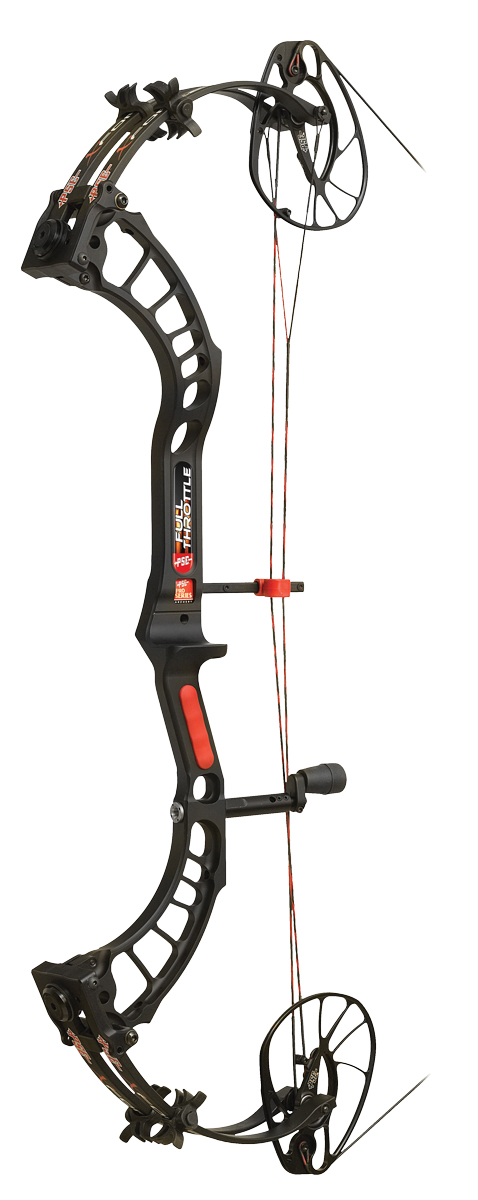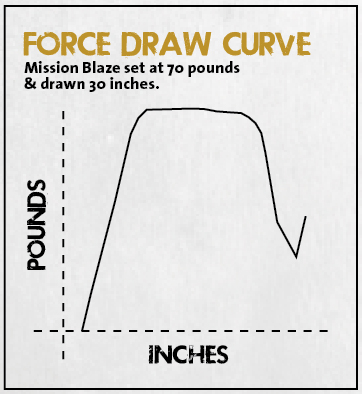PSE released no fewer than 17 new bows for 2014. With a line-up that big, PSE can produce something for everyone, and in recent years that line-up has included a number of excellent bows that are on the fast side while being very smooth and easy-shooting. Despite that, PSE retains a justified reputation for designing what founder Pete Shepley has referred to as “bows that perform”—by which he means “very fast bows.”
At 370 fps, the aptly named Full Throttle is the fastest bow in production. The former record went to last year’s Omen, a PSE bow that reached a top  speed of 366 fps. APA’s King Cobra approached that at 362 fps, and a number of bows come in around 350 fps, give or take a few feet. How does the Full Throttle do it? It’s an uncompromising speed bow, and some of the features that make it very fast are obvious at a glance, beginning with a brace height of 5.25 inches. That is skinny by any standard. The large Full Throttle Cams, designed expressly for this bow, are aggressive and draw-length-specific to eke out maximum efficiency. No doubt PSE’s aggressively pre-loaded limbs contribute to the speed, as well. Even the five speed nocks at either end of the string suggest “built for speed.” Less visible but also a factor is the 70 percent letoff, as opposed to the more commonly seen 75 or 80 percent letoff.
speed of 366 fps. APA’s King Cobra approached that at 362 fps, and a number of bows come in around 350 fps, give or take a few feet. How does the Full Throttle do it? It’s an uncompromising speed bow, and some of the features that make it very fast are obvious at a glance, beginning with a brace height of 5.25 inches. That is skinny by any standard. The large Full Throttle Cams, designed expressly for this bow, are aggressive and draw-length-specific to eke out maximum efficiency. No doubt PSE’s aggressively pre-loaded limbs contribute to the speed, as well. Even the five speed nocks at either end of the string suggest “built for speed.” Less visible but also a factor is the 70 percent letoff, as opposed to the more commonly seen 75 or 80 percent letoff.
As a Pro Series bow it boasts all the latest PSE technology, including the Flex Cable Slide, the Vibracheck Limb Damper Bands, and the Backstop 2 micro-adjustable string stop. Axle-to-axle is a moderate 33.25 inches, and the weight is slightly on the heavy side at 4.1 pounds. (Arguably a plus for a bow this fast.) Draw weight is adjusted by loosening set screws and backing out the limb bolts; since draw length is cam-specific, changing more than a very small amount by twisting string or cable requires a new cam. Fit and finish is, as you might expect on a Pro-Series bow from PSE, is excellent, and there were no visible flaws of any kind on the bow tested.
Shooting The Bow
Orientation marks on the shelf and riser are simple, but useful features that make installing the rest for vertical alignment and center shot a quick and easy operation. I did not test broadheads, but the initial setup using only the orientation marks and my eyes resulted in excellent arrow flight and accuracy using field points. The limb bolts were extremely tight, but that is a minor inconvenience at most to most shooters, who are unlikely to be making frequent draw weight changes. PSE recommends backing off four turns from peak weight before pressing the bow, which I did in order to install a peep sight. A minor adjustment was required for the string stop, which took all of about 30 seconds.
At 4.1 pounds the Full Throttle is not a light bow, but neither is it inordinately heavy. Like most compound bows it’s a little top-heavy, and the slightly long (by current standards) axle-to-axle makes this a little more noticeable when carrying (though not when shooting) the bow.
We mentioned the skinny brace height. The widely held view is that a skinny brace height is less forgiving than a wider one. The theory is that the shorter draw stroke created by a wide brace height results in the arrow being released from the string sooner, meaning that any shooter-induced torque, tendency to grab the riser or drop the bow arm, or any other imperfection in form will have less opportunity to influence the arrow flight. In practice, any such effect is debatable. It does appear that, depending on anatomy and shooting form, a skinny brace height may increase the likelihood of string contact with the shooter’s arm or sleeve. That is a strictly individual matter and, in any case, was not an issue for me when shooting this bow.
Bow makers, including PSE, have gotten closer to the “free lunch” of maximum speed without sacrificing shootability than anyone believed possible a decade ago. Still, the laws of physics are immutable, and extra speed comes at some sort of cost, somewhere. The cams on the Full Throttle are aggressive, and the shooter will feel the weight on the draw. On the other hand, it’s an even pull with no harsh humps or bumps in the draw cycle, nor is there an arm-wrenching stop after the break-over (assuming the shooter isn’t over-bowed). The Draw Force Curve bears this out, showing a steep climb to full draw weight, then a long, smooth pull at about the same weight until dropping into the valley at the very end.
The valley is on the narrow side, and the shooter who is over-bowed, shooting at too long a draw length, or not drawing properly through the shot may find this an issue. These factors aside, some shooters just prefer a wider valley.
Given the speed, I was mildly surprised by the draw. The shot was a bigger surprise. The bow is quiet, especially for its speed; there is no hand shock, and any vibration is minimal, at least with a stabilizer in place. There is no discernible torque, no recoil, and no sense of a “touchy” or unforgiving setup. I was shooting tight groups immediately. And the arrows do reach the target noticeably faster and, not surprisingly, are a little more difficult to extract because of deeper penetration. (In fact, I turned my 20-inch Block target to make sure I was shooting through the deep part of it, especially when using the 500-grain arrows. The point still exited the far side of the target by several inches.)
Make no mistake, the Full Throttle is not a bow for everyone. For the bowhunter who shoots regularly enough to be well-conditioned, and who likes to take advantage of maximum speed for flatter trajectories and longer range, less effect from wind in windy environments, or added penetration when hunting big, dangerous game, the Full Throttle is a bow well worth test driving.
PSE Full Throttle Specs
Letoff: 70%
Brace Height: 5.25 inches
Weight: 4.1 pounds
Axle-To-Axle Length: 33.25 inches
Speed: up to 370 fps
Draw Lengths: 24.5 to 30 inches
Draw Weights: 50, 60, 65, 70 pounds peak, adjustable down 10 pounds from peak
Options: Finishes in Skullworks, Mossy Oak Break-Up Infinity, Solid Black
Suggested Retail: $1,100
Objective Tests (30 Inches Draw)
Peak Hold*: 70 pounds
Weight, Full Draw*: 26.5 pounds
*Rounded to nearest half-pound
At 70-Pound Draw Weight
| Arrow Weight | Speed @ Launch | Speed @ 20 Yards | K.E. @ Launch | K.E. @ 20 Yards |
| 385 grains | 344 fps | 330 fps | 101 ft. lbs. |
93 ft. lbs. |
| 500 grains | 309 fps | 300 fps | 106 ft. lbs. | 100 ft. lbs. |
At 60-Pound Draw Weight
| Arrow Weight | Speed @ Launch | Speed @ 20 Yards | K.E. @ Launch | K.E. @ 20 Yards | Sound Level |
| 385 grains | 315 fps | 303 fps | 85 ft. lbs. | 78.5 ft. lbs. |
59.8 dBA |
| 500 grains | 282 fps | 274 fps | 88.5 ft. lbs. | 83.5 ft. lbs. | 57.6 dBA |







